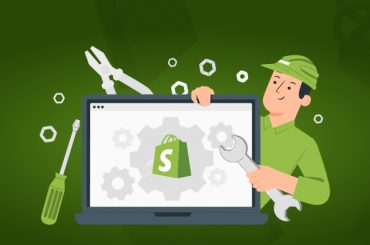Shopify Plus vs. Adobe Commerce (Magento) Total Cost of Ownership Comparison
Last Updated | April 26, 2024
Table of Contents
Understanding the total cost of ownership is a critical factor in choosing the right e-commerce platform for your business. This blog comprehensively compares two industry-leading platforms, Shopify Plus and Adobe Commerce (Magento), to help you make an informed decision that aligns with your long-term financial goals.
Our analysis is structured around key factors that influence the total cost of ownership, including initial setup costs, maintenance expenses, scalability, and customization options. By examining these factors in detail, we aim to provide you with valuable insights that can guide your decision-making process and contribute to the success of your online store.
Total Cost of Ownership – Explained
Let’s simplify the concept of Total Cost of Ownership (TCO). It is the sum of all costs associated with a product, service, or asset, not just the initial purchase price. Ignoring ecommerce TCO can lead to inaccurate evaluations. It’s a crucial tool that provides a clear understanding of the long-term financial impact of a purchase.
Acknowledging TCO helps businesses make more informed decisions regarding current and future investments. TCO also helps individuals realize the actual and final value of their purchase. Several factors affect ecommerce TCO, most notably:
- Acquisition costs (purchase price, freight charges, tax, and installation)
- Operating costs (repairs, maintenance, supplies, employee training)
- Management costs (licensing fees, IT support, software subscriptions)
- Downtime costs (lost productivity due to the asset being unavailable)
- End-of-life costs (recycling and disposal costs)
Here is an example:
Imagine buying a new car with two options (A and B). Car A has a lower sticker price and is the better upfront deal. However, it has lower fuel efficiency and higher maintenance costs than Car B, which costs more upfront. Car B has better fuel economy and significantly lower maintenance costs thanks to better-quality parts and assembly. Additionally, its price doesn’t depreciate as aggressively as Car A’s.
An examination of the total cost of ownership, including purchase price, fuel cost, maintenance, depreciation, and parts over the years, shows that car B has a much lower total cost of ownership. You may pay more upfront but save lots of money in the long term compared to car A, which becomes a money pit soon after you buy it.
Shopify Plus – An Overview
Shopify is the best starter eCommerce platform for small and medium-sized businesses. Shopify Plus is their premier service tier, offering all the bells and whistles. Here, we walk you through an overview of Shopify Plus and the different facets of its operations.
Initial and Set-up Costs
Shopify Plus is a monthly subscription at $2500/mo. (1 year) and $2300/mo. (3 years). At this price, users get the standard functionalities and integrations. Shopify allows you to integrate third-party applications and tools to improve store functionality and customize store design, functionality, and even customized store development.
Integration and Customization
Shopify Plus lets you integrate free and paid apps from the Shopify app store. Both free and paid apps enhance store functionality; however, incorporating premium applications adds to your monthly operating costs.
Custom development can build just what you need if you want functionality beyond app store options. However, this customization will come at a cost, so it’s important to know what you’re getting into before you go all in.
Hosting and Maintenance
Shopify is a fully hosted platform so that you won’t worry about maintenance and service costs. This makes Shopify stand out from other self-hosted solutions.
Training and Support
Shopify Plus users have 24/7 support and access to dedicated merchant success managers, giving them all the help they need with their stores. Basic training is included, while complex functionality could require additional support and training sessions.
Upgrades and Scalability
Countless eCommerce businesses use Shopify globally to handle billions of customers. With Shopify Plus, your eCommerce website can handle high website traffic and order volumes. This is great for businesses with growing customer bases.
Adobe Commerce (Magento) – An Overview
Magento is a world-renowned B2B eCommerce platform recently rebranded as Adobe Commerce. This section covers the total cost of ownership when building a store on Magento.
Initial and Set-up Costs
Adobe Commerce has a tiered licensing model with costs depending on your store’s estimated gross merchandise value (GMV). Adobe commerce pricing also depends on your choice of features, of which there are many, owing to the extensive customization options available.
Building an Adobe Commerce store requires developmental experience, influencing the set-up costs. Prices change depending on how complex and functional you want your store to be, with different designs and features.
Integration and Customization
The Adobe Commerce extension marketplace offers various extensions with different functionalities. Users can choose from free and premium versions and build custom integrations if they need unique functionality.
Opting for premium or custom integrations can increase the initial cost. Remember that you can phase in pricey additions over time instead of paying a hefty upfront fee.
Hosting and Maintenance
Unlike Shopify Plus, which is fully hosted, Adobe Commerce offers two solutions: self-hosting and using Adobe Commerce Cloud.
Self-hosting your Adobe Commerce store will allow you to manage the technical aspects of the website and the business itself. You will have to manage servers yourself, which saves money but increases your workload. With Adobe Commerce Cloud, store owners get a fully managed solution that covers all the bases at an additional cost.
You cannot wholly automate this aspect of your business; the store will still require maintenance in the form of bug fixes, security updates, and performance optimization. Maintenance can be internal with an IT team or outsourced—both will cost money.
Training and Support
Adobe Commerce users have access to their support pages with different service tiers, with the cost depending on which package you choose. For a large online business with staff, teams need training using internal resources and external training programs.
Upgrades and Scalability
Adobe Commerce is highly scalable, accommodating business growth across the board. However, scaling with Adobe Commerce requires additional developmental effort to add features and maintain customizations. If you’re running multiple Adobe Commerce stores, you will need extra resources and licensing fees depending on the scale of your business.
Picking the Right Platform
Selecting the right eCommerce platform depends on your business’s unique characteristics and long-term financial outlook. There are two factors to consider when choosing between Shopify Plus and Adobe Commerce: business type and size and long-term financial considerations.
Business Type and Size
Different businesses have different eCommerce needs; for example, a fashion brand will differ from an auto parts business. Different companies have different product catalogs, some more diverse or complex than others.
A small startup will pick an eCommerce store with low upfront costs, and large businesses will opt for a platform with high scalability. Additionally, sales volume will drive this decision since some platforms are better suited to handle the traffic.
Long-Term Financial Considerations
When deciding, the total cost of ownership, possible integrations, developmental efforts, hosting choice, and long-term maintenance must be considered. Your business should have a scalability plan to reference when picking a platform.
Some platforms have tiered plans that are ideal for scaling your business. You can upgrade a plan each time the old one reaches its maximum potential. Additionally, extensive customization will require extra development and effort. Shopify Plus comes with several built-in features, while Adobe Commerce offers extensive customization.
Your decision regarding these factors influences the total cost of ownership, ease of business, and customer satisfaction. It is imperative to ensure the business has a proper action plan for the present and future when picking a platform to build its business.
| Feature | Shopify Plus | Adobe Commerce |
| Business Size | Medium to Large | Large, Enterprise |
| Initial Cost | Lower | Potentially Higher (licensing) |
| Development Needs | Lower (more built-in features) | Higher |
| Hosting | Fully Hosted | Self-Hosted or Cloud |
| Support | Included | Optional |
| Scalability | Good | Excellent |
| Long-Term TCO | Potentially Lower (no extra development) |
Potentially Higher
(potential extra development) |
Conclusion
Understanding the total cost of ownership is crucial when choosing the right e-commerce platform for your business. In this blog, we compare two prominent players in the e-commerce industry: Shopify Plus and Adobe Commerce (formerly Magento).
By examining factors such as licensing fees, customization costs, maintenance expenses, and scalability, we aim to provide valuable insights to help you make an informed decision for your online store. Join us as we break down the total cost of ownership for Shopify Plus and Adobe Commerce, empowering you to choose the platform that best aligns with your business goals and budget.









